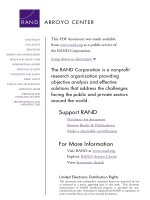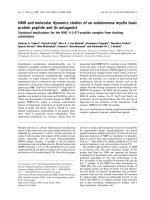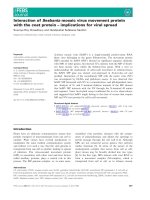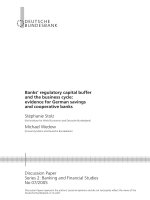Antidumping, competition and the WTO system implications for vietnamese legal reform
Bạn đang xem bản rút gọn của tài liệu. Xem và tải ngay bản đầy đủ của tài liệu tại đây (2.67 MB, 357 trang )
A
A
N
N
T
T
I
I
D
D
U
U
M
M
P
P
I
I
N
N
G
G
,
,
C
C
O
O
M
M
P
P
E
E
T
T
I
I
T
T
I
I
O
O
N
N
A
A
N
N
D
D
T
T
H
H
E
E
W
W
T
T
O
O
S
S
Y
Y
S
S
T
T
E
E
M
M
IMPLICATIONS FOR VIETNAMESE LEGAL REFORM
TRAN VIET DUNG
LL.B (Hon.), Ho Chi Minh City University of Law
LL.M (Hon.), Transnational Law and Business University
A THESIS SUBMITED FOR THE DEGREE OF
DOCTOR OF PHILOSOPHY
FACULTY OF LAW
NATIONAL UNIVERSITY OF SINGAPORE
2007
ACKNOWLEDGEMENTS
First and foremost, my sincere thanks to the National University of Singapore for granting me
the research scholarship to write this thesis. I am especially grateful to my supervisor,
Professor Hsu Locknie for her support and encouragement throughout my graduate study in
Singapore. Her technical and editorial advice was essential to the completion of this thesis and
she has taught me innumerable lessons and insights on the workings of academic research in
general.
I would also like to thank Professor Alan Tan Khee Jin, Professor Victor Ramraj, Professor
Teo Keang Sood, Professor Koh Kheng Lian, Professor Sornarajah, Professor Wang Jiangyu,
Professor Michael Ewing Chow for their support and encouragement. My sincere thanks to
Normah Bte Mahamood, whose assistance in administrative matters was invaluable.
I am also very grateful to my faculty-mates and friends in Normanton Park Vu Dai
community for their great friendship and support. Many thanks go to my friend Hoang Viet. I
am fortunate to have his friendship that has led to many interesting discussions and making
the hard work real fun. I also appreciate Hoang Long, Bedabrata, Aisulu, and Anna Toh for
their friendship and help with English editing.
I am also grateful for the invaluable support of the US-Vietnam Trade Council, Asia Research
Institute, Ho Chi Minh City University of Law and the Vietnam Competition Administration
Department.
Last but not least, I would like to express my deepest gratitude and love to my parents for
their dedication and the many years of support during my undergraduate and graduate studies
that provided the foundation for this work. I would also like to thank my wife, Tuyet Dung for
always being my wonderful companion, and my little son Khoi - a bright spark of my life.
Tran Viet Dung
December 2007
i
TABLE OF CONTENTS
Acknowledgments i
Table of Contents ii
Summary vii
List of Figures and Charts ix
List of Abbreviations x
CHAPTER I
ANTI-DUMPING LAW AND POLICY: ECONOMIC, LEGAL,
STRATEGIC CONSIDERATIONS
1.1 Introduction 01
1.2 Dumping And The Law Against Dumping 03
1.2.1 The Notion of Dumping 03
1.2.1.1 Economic Definition of Dumping 04
1.2.1.2 Legal Definition of Dumping 07
1.2.2 Economic Analysis on Dumping 10
1.2.2.1 Price Discrimination 10
1.2.2.2 Sale-Below-Cost 12
1.2.3. Welfare Impacts of Dumping 16
1.2.3.1 Impacts of Dumping on Importing Country 16
1.2.3.2 Impacts of Dumping in Exporting Country 20
1.2.3.3 Concluding Remarks on the Welfare Impacts of Dumping 22
1.2.4 Rationales of Anti-Dumping Laws 22
1.2.4.1 Economic-Efficiency Argument 23
1.2.4.2 Protection of Comparative Advantage 27
1.2.4.3 Social Considerations 29
1.2.4.4 Maintenance of Fair Competition 30
1.2.4.5 Political Economy Rationale 32
1.2.5 WTO Anti-Dumping Rules
and Some Critical
Issues Arising From National Anti-Dumping Practices 35
1.2.5.1 The Determination of Dumping and Dumping Margin 36
1.2.5.2 Dumping Causation Determination 39
1.2.5.3 Anti-dumping Duties 41
ii
1.3 Anti-dumping and Competition Policy 43
1.3.1 Competition Policy: Objectives and Scope 43
1.3.2 Anti-dumping Laws vs. Competition Laws 46
1.3.3 Summary 51
1.3.4 Perspectives of Development of the Legal Regime against Dumping 51
1.3.4.1 Replacement of Anti-Dumping Laws With Competition Laws 51
1.3.4.2 Establishment of a Filter System For Anti-Dumping Regime 55
1.4 Conclusion 59
CHAPTER II
VIETNAM’S DEVELOPMENT BACKGOUND
2.1 Introduction 60
2.2 The “Doi Moi” Policy and Economic Integration 61
2.2.1 Economic reforms 61
2.2.2 Doi Moi in Foreign Trade Policy 65
2.2.3 Economic Integration – More outside Pressures on Trade Reforms 69
2.3 Insights of the Legal System 75
2.3.1 Adoption of Rule of Law Concept In The Legal System 75
2.3.2 Rule-Making and Rule-Implementing 77
2.3.3 Achievements and Issues in Developing a Modern
Foreign Trade Regime 83
2.3.3.1 Revision of Economic Laws and Regulations 83
2.3.3.2 Judicial Review System 87
2.3.3.3 Transparency Issue 89
2.4 Conclusion 92
CHAPTER III:
VIETNAM’S ANTI-DUMPING SYSTEM: AN OVERVIEW
3.1 Introduction 94
3.2 Vietnam’s Perspective on Development of The National
Anti-dumping System 94
3.2.1 The Problems of Foreign Anti-Dumping Practice 95
3.2.2 Problems of Foreign Dumping 100
iii
3.2.2.1 Chinese Motorcycle Imports Case 101
3.3 Development of the National Anti-dumping Law 105
3.3.1 Brief Legislative History 105
3.3.2 Significance of the New Anti-Dumping Legislation 110
3.4 Insights of the Anti-dumping System 113
3.4.1 Legal and Institutional Framework of the Anti-Dumping System 113
3.4.1.1 Legal Framework 113
3.4.1.2 Institutional Framework 117
3.4.2 Legislative Intention of the Anti-Dumping Policy 120
3.4.3 Linkage between Anti-dumping
and Competition Policies in Vietnam 124
3.4.4 Competition Policy Considerations Within the Anti-Dumping Policy 127
3.5. Some Strategic Policy Considerations 131
3.5.1 Improve the Substantive Content of The Legislation 132
3.5.2 Focusing More on Due Process and Operation of
Anti-Dumping Authorities 133
3.5.3 Improvement of Transparency 135
3.5.4 Necessity of Judicial Review Regulations 137
3.5.5 Rising the Public Understanding of The National Anti-Dumping System 137
3.6 Conclusion 139
CHAPTER IV
VIETNAM’S ANTI-DUMPING LAW: SUBSTANTIVE ISSUES
4.1. Introduction 140
4.2. Injury Determination 141
4.2.1. Normal Value Determination 142
4.2.1.1. Exporter’s Domestic Price 144
4.2.1.2. Like Product 148
4.2.1.3. Where the Exporter’s Domestic Price Cannot Be Ascertained 159
4.2.1.4. Export Price to Third Country 166
4.2.1.5. Constructed Normal Value 167
4.2.3. Export Price Determination 182
4.2.3.1. The Price Actually Paid or Payable 183
iv
4.2.3.2. Constructed Export Price 184
4.2.4. Determination of Dumping Margin 187
4.2.4.1. Fair Comparison 187
4.2.4.2. Comparison Methods 190
4.3. Injury Determination 193
4.3.1. Domestic Industry 194
4.3.2. Material Injury 197
4.3.2.1. Volume Effects of Dumped Imports 199
4.3.2.2. Price Effects of Dumped Imports 201
4.3.2.3. Impact of Dumped Imports on the Domestic Industry 204
4.3.3. Cumulation of Injury 207
4.3.4. Threat of Material Injury 213
4.3.5. Causation 215
4.3.6. Public interest clause 217
CHAPTER V
VIETNAM’S ANTI-DUMPING LAW: PROCEDURAL ISSUES
5.1. Introduction 227
5.2. Initiation of the Anti-Dumping Investigation 229
5.2.1. Standing to File a Private Petition 231
5.2.2. Petitions 235
5.2.3. Acceptance or Rejection of Petitions 238
5.2.3.1. Time Limits for Making Decision to Initiate the Investigation 240
5.2.3.2. Acceptable Contents 241
5.2.3.3. Evidence 244
5.2.3.4. Other Grounds for Rejecting Petitions 245
5.3. Anti-Dumping Investigation 247
5.3.1. Parties to anti-dumping proceeding 249
5.3.2. Investigation Techniques and Due Process Rights 251
5.3.2.1. Investigation Periods 251
5.3.2.2. Questionnaires 257
5.3.2.3. Protection of Confidential Information 262
5.3.2.4. Inspection of non-confidential information 267
5.3.2.5 Hearings 268
5.3.2.6. Best available information 271
v
5.3.3. Anti-dumping Measures 275
5.3.3.1. Anti-dumping duties 275
5.3.3.2. Undertakings 282
5.4. Standard Administrative and Judicial Reviews 282
5.4.1. Standard Administrative Reviews 282
5.4.1.1. Sunset Reviews 288
5.4.2. Judicial Reviews 290
5.4.2.1. Legal Basis for Judicial Reviews 290
5.4.2.2. Original Jurisdictions and Venues 292
5.4.2.3. Standing 295
5.4.2.4. Standards of Judicial Reviews 296
5.4.2.5. Some Legal Implications 301
Chapter VI
CONCLUSION: MAIN FINDINGS, RECOMMENDATIONS AND
SUGGESTIONS FOR FURTHER RESEARCH
6.1. Findings 305
6.2. Recommendations 308
6.2.1. General anti-dumping policy 309
6.2.2. Regulatory Design 313
6.2.2.1. Normal Value and Export Price 314
6.2.2.2. The Dumping Margin 316
6.2.2.3. Determination of Injury 317
6.2.2.4. Public interest considerations 318
6.3. Some Competition Policy Considerations to Change the System
In The Future 319
6.4. Final Thoughts 322
Postscript 324
Bibliography 325
Appendix A: Anti-dumping Ordinance 335
vi
SUMMARY
This PhD thesis is a result of the author’s research on the development of anti-dumping law
and policy of Vietnam in the light of its ongoing economic reforms and recent successful
accession to the WTO multilateral trading system. It investigates the theoretical and practical
implication of anti-dumping law with regards to promotion of trade liberalization, fair
competition and economic development for Vietnam. During the study this author tries to
assess critically the existing rules governing the Vietnamese anti-dumping system from the
competition and economic efficiency perspective. Overall, the thesis seeks to provide some
contributions to the stock knowledge concerning anti-dumping law and policy in Vietnam and
provide suggestions for development of the national anti-dumping system.
The thesis begins with an introductory Chapter I, which
presents theoretical discussions on
the economic rationales of dumping and the law against dumping. In particular, this chapter
introduces an analysis on the contradiction and linkage between anti-dumping and
competition policies in the context of current development of international trade. The analyses
help to identify the problems of anti-dumping rules as well as to determine the possibilities of
improving and strengthening the rules.
Chapter II offers to illustrate the economic, political and legal developments in Vietnam
during the last two decades under the “Doi Moi” Policy. In particular it considers the
Vietnamese political and legal infrastructure within which anti-dumping law and policy is
designed and developed. This helps to give a broad overview of the objective and subjective
problems of Vietnamese anti-dumping system as well as the possibility of improvement.
Chapter III seeks to provide a succinct review of the Vietnam’s anti-dumping system,
including its development rationales, underline objectives, and historical developments. It also
examines whether or not, and to which degree, the Vietnamese government takes into account
the economic efficiency and competition policy considerations while designing and
developing the national anti-dumping system. It then proposes some strategic considerations
for development of the national anti-dumping system.
vii
Chapter IV and Chapter V concentrate on the substantive and procedural issues of the
Vietnamese anti-dumping legislation. Existing anti-dumping rules are analyzed and compared
with relevant analogue legislation of other countries in the world and particularly with the
regulations of the ADA. Chapter IV reserves a special focus on the analysis of development
of an effective public interest assessment mechanism in Vietnam because it is believed that
this mechanism will help best to balance the interests of domestic producers and that of
consumers in anti-dumping proceeding.
Finally, Chapter VI concludes the thesis by summarizing the principal findings of the studies
and proposing some recommendation for development of a pro-competitive anti-dumping
system in Vietnam. Certain features for a reform in the area of anti-dumping in the long-run
are also proposed in this final part of the thesis.
viii
LIST OF FIGURES AND CHARTS
Figure 1: Economic and Inflation (%) 64
Figure 2: Foreign Investment Flow in Vietnam 65
Figure 3: Vietnam’s Export and Import Turnover 69
Chart 1: Vietnam’s legislative documents 81
Chart 2: Vietnam’s Anti-dumping investigation 229
Chart 3: Investigation periods 256
Chart 4: Vietnam’s Court System 294
ix
LIST OF ABBREVIATIONS
ADA Anti-Dumping Agreement (Agreement on Implementation of
Article VI of GATT 1994)
ADSO Administrative Dispute Settlement Ordinance
ASEAN
Association of Southeast Asian Nations
AFTA ASEAN Free Trade Agreement
APEC Asia-Pacific Economic Corporation countries
BTA Bilateral Trade Agreement
CADP Committee on Anti-Dumping Practices
CEPT
Common Effective Preferential Tariff
CIF cost, insurance and freight
COMECON Council for Mutual Economic Assistance
CVD countervailing duty
CKD complete-knock-down
DRAMS dynamic random access memory semiconductor
DSB Dispute Settlement Body
DSU Dispute Settlement Understanding
DOC Department of Commerce of the United States
FDI Foreign Direct Investment
G&A general and administrative (costs)
GAAP generally accepted accounting principles
GATT General Agreement on Tariffs and Trade
GDP Gross Domestic Product
GSO General Statistical Office of Vietnam
HFCS High Fructose Corn Syrup
HS Harmonized System
ITC International Trade Commission
L/C letter of credit
LC&D Law on Complaints and Denunciations
MOF Ministry of Finance of Vietnam
MOFA Ministry of Foreign Affairs
x
MOJ Ministry of Justice
MOT Ministry of Trade
OECD Organization for Economic Co-operation and Development
PET polyethylene terephthalate
PSF polyester staple fibres
PTA purified terephthalic acid
SG&A selling, general and administrative expense
SKD semi-knock-down
UNCTAD United Nations Conference on Trade and Development
UNDP United Nations Development Program
VCAD Vietnam Competition Administration Department
WTO World Trade Organization
xi
CHAPTER I
ANTI-DUMPING LAW AND POLICY: ECONOMIC, LEGAL,
STRATEGIC CONSIDERATIONS
1.1. INTRODUCTION
Since its inception, the General Agreement on Tariffs and Trade (GATT) has already
authorized signatories to apply anti-dumping measure in the form of special duties to offset
dumping when it causes or threatens to cause material injury to its domestic industry. Anti-
dumping laws are considered as an essential element of national foreign trade policies of
countries supporting trade liberalization and open international trade. National anti-dumping
legislation dates from well before the GATT. The first anti-dumping law was enacted by
Canada in 1904. Many other western countries, including Australia, New Zealand, South
Africa, and the United States adopted a similar law over the following two decades.
Nowadays, over 98 countries in the world have already adopted the anti-dumping law and are
ready for action against dumping in defence of their domestic industry.
1
Vietnam is among the
newest member of the anti-dumping cohort after the adoption of its first anti-dumping
legislation – the Anti-dumping Ordinance, in 2004.
1
Zanardi, M., “Anti-dumping: a problem in international trade”, Paper for Conference: 100
th
Annivesary of
Anti-dumping Regulations, Leverhulme Center for Research on the Globalization and Economic Policy
(GEP), University of Nottingham, 25-26 June, 2004. p.2
1
Despite their longstanding popularity, anti-dumping laws are frequently subject to sharp
criticism, especially from academic economists. The criticisms often attack the methods and
principles of anti-dumping for their lack of economic rationale while accessing the issue of
dumping. It is further argued that anti-dumping laws actually do not protect fair competitive
market but rather they are to protect domestic producers against international competition.
The misuse of anti-dumping laws for the purpose of protectionism can be quite detrimental to
economic development as national resources will be misallocated and substantial interests will
be vested in the wrong industries.
This Chapter, therefore, focuses on analyzing the theories on dumping and anti-dumping
policy. The first part of this Chapter concentrates on the review of arguments - economic,
social and political – to the desirability of countries, especially those of developing
economies, in designing and developing anti-dumping regime. It is believed that to decide
whether anti-dumping measures provide beneficial economic outcomes for the country, one
must assess the economic theory on dumping and anti-dumping and contrast the results of
such system with that of a market without any competition. The political economic theory of
anti-dumping laws will also help to explain the rationale of these trade remedy instrument.
The second part of this Chapter includes the analysis of anti-dumping measure versus
competition policy. Since one of the main arguments of anti-dumping measure is that this
trade remedy instrument serves to (temporarily) counter unfair competition arising from
international price discrimination, anti-dumping laws should also be assessed in the light of
the general theory of competition policy. This analysis will help to determine the possibilities
of improving and strengthening the national anti-dumping regime.
2
1.2. DUMPING AND THE LAW AGAINST DUMPING
1.2.1. The Notion of Dumping
The origin of the word “dumping” is uncertain. According to Richard Dale, its usage was
recorded in the early 19
th
century, with the meaning of the act of getting rid of something
unwanted in a lump or mass.
2
At the beginning of 20th century, the term began to be used in
English trade-literature to describe the situation in which products were sold cheaply in
foreign markets,
3
the implication being that the products were unwanted in their country of
origin and were exported only to get rid of them. John Jackson, meanwhile, relates that Adam
Smith was the first to use the word dumping, but in reference to situations approximately to
the extent of the nowadays term of “export subsidy”.
4
Today, the word dumping is used
internationally to signify the practice of price discrimination in international trade, which
includes a pejorative connotation. Dumping is usually associated with “unfair” and
“undesirable” trade practices.
As such, the word ‘dumping’ is commonly regarded as unfair or abusive merchandise activity
and it is an arguable point of view that much of the supposedly remedial legislation in this
area is derived from moral opprobrium attached to dumping rather than from any objective
damage it may cause.
5
2
Dale, R., “Anti-dumping law: in a liberal trade order”, Trade Policy Center, London, (1980), p. 1.
3
Ibid.
4
Jackson, J., “Dumping in International Trade: Its Meaning and Context”, in Jackson, J. and Vermulst (eds.)
“Anti-dumping Law and Practice”, University of Michigan Press, (1991), pp. 4-5
5
Dale, R., “Anti-dumping law”, supra note 2, p. 1
3
1.2.1.1. Economic Definition of Dumping
The most traditional economic definition of dumping, which was first suggested by Jacob
Viner, is price discrimination between national markets.
6
This situation occurs when firm sell
products to the importing country
at a price below that which it sells like products in its
domestic market. Efforts to quantify whether dumping was occurring, however, led to the use
of criteria for determining the “domestic price” by omitting domestic sales which are below
cost of production.
7
Thus, the term dumping has been understood also as a transnational “sale
below cost”. Economic theories of dumping nowadays have paralleled these developments.
According to the classic theory of price discrimination, the merchandise practice of price
discrimination occurs only when different units of the same products are sold at different
market for different price for reasons not associated with differences in costs. Such behavior
automatically implies some departure from the ideal of perfect competition. Deardoff
explained that situation as follows “… a perfectly-competitive firm would always try to sell its
products in the market with the higher price [to maximize profit]. If instead a firm cannot sell
6
Viner, J., “Dumping: A Problem in International Trade”, University of Chicago Press, Chicago, (1923).
Ever since Viner published his classic economic study in 1923, economists have characterized dumping as
cross-border price discrimination. See, e.g., Dam, K.,
“The GATT: Law and International Economic
Organization”, University of Chicago Press, Chicago, (1970) pp.168-169
(analyzing Viner's work and
discussing dumping as international price discrimination); Barcelo III, J., “Anti-dumping Laws as Barriers
to Trade - The United States and the International Anti-dumping Code”, Cornell L. Rev., 57, (1972) pp.
491-560 (analysis of Viner's Work). See also: Bierwagen, R., “GATT Article VI and the Protectionist Bias
in Anti-Dumping Laws”, Kluwer Law Int., The Hague, (1990), p.171; Boltuck, R., “An Economic Analysis
of Dumping”, J. World Trade L., Vol. 21, (1987), p. 45; Boltuck, R., Reply to Professor Lazar's Comment
on "An Economic Analysis of Dumping”, J. World Trade L., Vol. 22, (1988), p. 129; Lazar, F.,
Structural/Strategic Dumping: A Comment on Richard Boltuck's "An Economic Analysis of Dumping", J.
World Trade L., (1988), pp. 91-93; Deardorff, A., “Economic Perspectives on Anti-dumping Law”, in
Jackson, J., and Vermulst, E., (eds.) “The Multilateral Trading System”, (1989), pp. 23-40; Marceau, G.,
“Anti-dumping and Anti-trust Issues in Free Trade Areas”, Clarendon Press, Oxford, (1994), pp. 11-18;
Bhala, R., and Kennedy, K., “World Trade Law: the GATT-WTO System, Regional Arrangements, and U.S.
Law”, Lexis Law Pub., Charlottesville, (1998).
7
Deardoff, A., “Economic Perspectives on Anti-dumping Law”, Ibid., p. 135.
4
as much as it wishes in a given market within a specific period of time at a given price, then it
must set the price that it will charge based in part on how much it will then be able to sell. Its
pricing decision will depend on a variety of factors, and it would be only a coincidence if
these factors were to lead it to charge the same price in two different markets. If it does so,
then it is engaging in price discrimination”.
8
The price discrimination can not have taken place if the two markets were not separated. This
market separation can be social, political, geographical, cultural or legal. In the modern
context, economists often refer to the legal factors, i.e. high import tariffs, import restrictions
or technical standards, as examples which cause market isolation in international trade.
Without the separation of markets, consumers in one market would always come to the other
market with the cheaper price to buy the products or they might buy the cheap products in one
market and re-sell them in the other. In either case, the firms could not succeed in maintaining
a higher price in one of the two markets.
The other presupposition of price discrimination is that one of the two markets should be less
elastic than the other. The condition of low “elasticity” of demand in one separate market is
significant because it enables the firm to charge a higher price for the products without fear
that their sales volume will drop because of the price differences. If costs for supplying the
two markets are the same, then the larger markup will also result in a higher price. It is to say
if all the cost for supplying goods in the two markets is similar, but one of the markets is less
elastic than the other, than the sale price in the market with less elastic demand will be higher.
8
Ibid., p. 136
5
In the context of international trade, the price discrimination is termed as dumping only when
the sales price of the products in home country is higher than the export price of the products.
From an economic perspective, the market condition is an essential element but not sufficient
to bring about price discrimination. There are still two preconditions for a firm to engage in
international price discrimination. First, the firm should have a strong monopolistic - or at
least oligopolistic - position in its home market. It is assumed that firms can only manipulate
the price in both home market and foreign market when they possess sufficient market power
in their home market. Without such power, any price differential for merchandise products in
at least one of the markets would not be within their control. Second, firms must be also
protected from foreign competition at home-market by certain kinds of trade barriers. Only in
such circumstances, firms would face less elastic demand for its products in its home market
than abroad and will respond to that discrepancy by charging a higher markup at home than
abroad. If the extra costs of foreign sales are not too high, the actual price firms charge will be
lower in foreign market and this is regarded as dumping.
It is also necessary to differentiate between dumping and the granting of official export
subsidies. Although both practices may cause certain distortions in price order in the market
of importing country, they are distinct in the sense that dumping relates only to private
initiative to discriminate the price between markets. Export subsidies are related to
government support in the form of export bounties for exporters. Besides, the export subsidies
need not necessarily result in price discrimination even though the final result often does. The
two practices are usually regulated by separate legislation. Within the WTO framework, the
terminology of the measure in response to export subsidies is countervailing duty as distinct
from anti-dumping duty.
6
Beside the international price discrimination, dumping is also defined as exporting of products
at a price below cost of production. The exports below costs must be subsidized with other
sales above cost either at other times or in the other market (usually in the home market) or
otherwise firms would be conducting their operations at a loss. On the surface this condition
for transnational sale-below-cost is not much different from international price discrimination.
Hence, the sale- below-costs is often associated with unfair business practices because the
incentive of competitive firms is profit maximization. They cannot maintain unprofitable sale
without purpose. The sale-below-cost is considered as self-evidence that the exporting firms
will raise its price in the future after eliminating competitors in the targeted market and thus
achieving market dominance in order to recover their costs. This predatory business practice
is not healthy for competition.
1.2.1.2. Legal Definition of Dumping
Dumping has become subject of national legislation since 1904 with the introduction of the
first statute aimed specifically at dumping by Canada.
9
However, at the early stage of
development this term was defined differently in each national jurisdiction. Some countries,
i.e. Canada (1904), New Zealand (1905), Australia (1906) and South Africa (1920) defined
dumping as the case where merchandise was lower than its fair market value in the exporting
countries.
10
While the US Anti-dumping Act 1916 defined it as a criminal action of importer
to sell the imported merchandise at prices less than their actual market value in the country of
9
Viner, J., “Dumping”, supra note 6, p. 192; see also Dale, R., “Anti-dumping law”, supra note 2, p. 12
10
Viner, J., “Dumping”, Ibid., pp.192-209
7
production with the predatory intent of destroying or injuring the local industry.
11
Many
countries, i.e. Canada and UK, during the inter-war period (prior to the Second World War),
even associated dumping with a situation in which a country increased its export
competitiveness through an effective depreciation of its currency – so called “exchange-
dumping”.
12
This kind of dumping is not at all related to the price discrimination or dumping
in the economic sense.
13
Only after the Second World War, the legal definition of dumping has become gradually
standardized, a result of the negotiation between nations over the establishment of a post-war
international trade arrangement. It was against this background that in 1948 the General
Agreement on Tariff and Trade (GATT) took up the subject matter and formulate the first
international definition on dumping.
After the establishment of the World Trade Organization, the international community has
accepted that the standard legal definition of dumping is contained in Article VI of the GATT
and Agreement on Implementation of Article VI of the GATT (commonly known as the Anti-
dumping Agreement).
14
11
US Anti-dumping Act 1916, (15 U.S.C. § 72): “It is unlawful to any person … to import, sell or cause to be
imported … articles within the United States at a price substantially less than the actual market value or
wholesale price of such articles, at the time of exportation to the United States, in the principal markets of
the country of production, or of other countries to which they are commonly and systematically
exported…[if] such act or acts be done with the intent to destroying or injuring an industry of the United
States”. See also Dale, R., supra note 2, p. 12
12
Dale, R., “Anti-dumping law”, supra note 2, p. 13
13
Ibid.
14
With the establishment of the World Trade Organization in 1994, all the member countries are required to
bring the national legislations to conform to the relevant multilateral agreements of the organization. To that
end, all regulations and norms on anti-dumping legislation should be based on the guideline regulations of
the WTO.
8
Article 2 of the Anti-dumping Agreement (ADA) outlines the legal concept of dumping,
stipulated as follows: “A
product is to be considered as being dumped, i.e. introduced into the
commerce of another country at less than its normal value, if the export price of the product exported
from one country to another is less than the comparable price, in the ordinary course of trade, for the
like product when destined for consumption in the exporting country.
…When there are no sales of the like product in the ordinary course of trade in the domestic
market of the exporting country or when, because of the particular market situation or the low
volume of the sales in the domestic market of the exporting country, such sales do not permit
a proper comparison, the margin of dumping shall be determined by comparison with a
comparable price of the like product when exported to an appropriate third country, provided
that this price is representative, or with the cost of production in the country of origin plus a
reasonable amount for administrative, selling and general costs and for profits”.
This definition implies that dumping is an action of selling products to the importing country
at a price (export price) lower than the normal value of the products. The bases for
determination of the export price and normal value depend on the particular situation
prevailing in the country of origin or exporting country and the importing country. “Normal
value”, in the primary sense of Article 2.1 of the ADA, is equivalent to domestic market price
of the product in the country of origin or exporting country, or the supplier’s export price to a
third country or the cost of production in the country of origin. The comparison between this
price and export price conforms to the economic definition of dumping. The legal definition
of dumping includes both price discrimination and sale-below-cost.
9
Overall, the legal definition provided in Article 2 of the ADA is fairly similar to the economic
definition of dumping discussed in the previous sub-section. It implies that the legal concept
of dumping can be assessed through the economic analysis.
1.2.2. Economic Analysis on Dumping
1.2.2.1. Price Discrimination
In order to facilitate the economic analysis of dumping, economists usually propose motives
or rationales which support the dumping practices. Accordingly, there are various business
motives that encourage firms to maintain for certain period of time two different prices in two
different markets:
First, firms may consider applying dual price system in two markets for promotion purpose.
For instance, when they want to enter a new foreign market (separated with its home market
divided by certain trade barriers) where their product has no reputation, they may choose a
strategy to maintain a lower than normal price in the new market (but still at a profitable
level) for certain period to make the product known to consumers in the new market. This
motive of dumping has no intention to eliminate competition in the new market. Similarly,
when the exporting firms have no information about the new markets, this situation may lead
firms to make decisions on price in contracts before export costs are fully known. The
relevant prices may end up lower the than the normal selling price in the home market or even
lower than the variable costs, however this situation represents a wrongful evaluation of the
costs rather than a decision not to cover the marginal costs. This sale price is presumably not
harmful for competition in the new market if it lasts for a short period of time.
10
Second, the price discrimination may be applied in order to achieve economies of scale. If
prices of the products are controlled (by private monopolistic power or by government
intervention) in the domestic market, the reduction of price occasioned by increased output
may take place only in the foreign market. In that case, the exporter applies two different
prices for the products on the assumption that his action will have negligible effect on other
companies’ sales prices.
Third, exporting firms may also decide to maintain price discrimination when they are already
in the market. Such behavior may be facilitated by the fact that price of the products in the
home market is regulated by either private cartel or governmental influence but it need not be.
Fourth, another motivation of the firms to apply dumping is when they face a surplus in
production. In that case they may try to maintain domestic price, by disposing or exporting
surplus production to a foreign market, while continuing to produce at full capacity. Again,
the business behavior can be considered as normal if the export price is still slightly higher
than the marginal cost or over all lower than the average cost.
Finally, firms may cut prices for their exports in order to establish market power in a foreign
market. An exporting firm with sufficient market power in the home market may utilize
profits reaped in the domestic market to finance (cross-subsidization) export sales at abnormal
low–prices with a view to eliminate competitors in the importing country so as to eventually
gain the monopolistic profits there. This strategy is known as “predatory pricing”.
For most of the above mentioned hypotheses, the business rationales of firms are quite
acceptable standard for competition among firms. Economists only strongly condemn
predatory pricing strategy because it is clearly a harmful practice with regards to both
11
competition and welfare of the society. However, according to economic analyses, successful
predation only can take place when the predatory firm has sufficient market power to
withstand the price-cutting losses in the initial stages of predation to recover it at a later stage.
It is also held that predation is not possible in a situation of liberal market without import
barriers. These difficult conditions make a predation extremely difficult nowadays. However,
neither information nor market structure is perfect all over the world. Thus, trading states
should be aware of international predatory pricing in order to act against it.
Again, the problem in the above mentioned patterns are not based on the fact that there is a
difference in prices between the two markets itself, but rather the condition in the market is of
less elasticity and high level of concentration. It is the highly protected exporting market that
creates favorable condition for price discrimination.
1.2.2.2. Sale-Below-Cost
In order to facilitate the economic analysis of dumping as sale-below-cost it is important to
first distinguish various definitions of cost. The most important distinction, from the
economic theory, is between “average-cost” and “marginal-cost”. Average cost, also known
as fully allocated cost, includes all costs incurred by the firm divided by number of units it
produces. Economists might further classify the average cost into “average-fixed-cost” and
“average-variable-cost”. Variable-costs are said to be those which vary with output,
meanwhile, fixed-costs are those which do not. Marginal cost refers to extra costs needed to
produce an extra unit of production.
From the economic point of view the common formula of business activities of firms is to
maximize profits in the long-term. In accounting terms, producing an extra product should
12
yield at least the extra costs of producing that extra product (marginal costs of production). As
marginal costs are covered, producing at a price where at least some of the fixed-costs are
recouped can be considered a rational business practice. Otherwise, firms would engage in an
abnormal business practice which can distort market order and thus should be condemned and
restricted.
Although, in theory, it seems fairly easy to explain such behavior, in practice, the assessment
of business behavior of firms is a highly complex issue, especially in the context of
international trade. It is mainly because structure and allocation of costs vary with different
countries, management models, accounting methods, social institutions, culture, and
legislation. Moreover, in a multi-product, multi-national company, the identification of such
costs becomes even more difficult.
It is submitted that in order to make an even-handed assessment of the issue of sale-below-
cost in the international setting, it is highly significant to have a proper adjustment made to
the national differences. However, that is not an easy task because it requires a deep
knowledge and information about the cost of production, manufacturing process and business
tradition of a foreign country. Finally, the proper level of costs which is rational to derive at
when setting a price is also very problematic. There is no consensus between economists as to
which cost must be taken as criteria or parameter for what constitutes “cost of production” in
order for one to determine whether a price really covers its costs of production.
15
Some
15
Marceau, G., “Anti-dumping and Anti-trust Issues”, supra note 6, p. 33.
13









